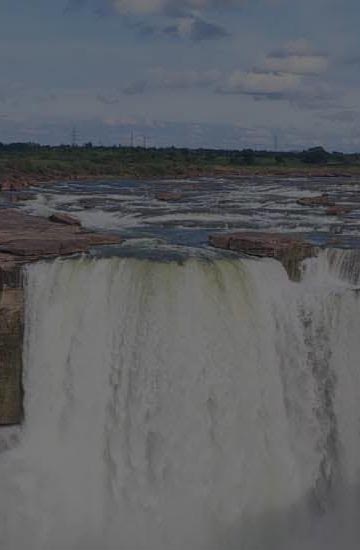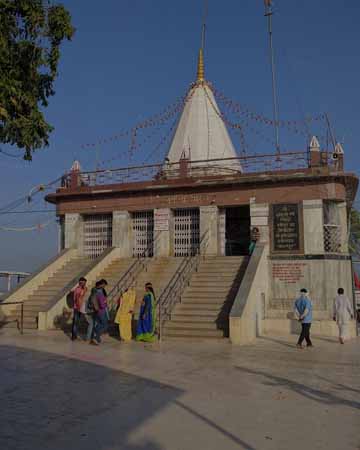Purwa Falls -
The Purwa Falls is a waterfall near Semariya, a town in Rewa Madhya Pradesh.It is nearby Basavan Mama, a sacred and tourist place. The Tamas River while descending through the Rewa Plateau and draining northwards makes a vertical fall of 70 metres (230 ft) known as the Purwa Falls. It is an example of a nick point caused by rejuvenation. Knick point, also called a nick point or simply nick, represents breaks in slopes in the longitudinal profile of a river caused by rejuvenation. The break in channel gradient allows water to fall vertically giving rise to a waterfall and present one heck of a robust view. The fall is intense and an enormous volume of water falls every second. However, the Fall gains or loses its majesty with season and is best to witness in the Rainy Season.
Basaman Mama: Amazing groom who sacrificed for a tree +
Historical and mythological religious place of Vindhya region which is known today as Basaman Mama. Even today, on the Satadhara Ghat of the river Tamas, a mausoleum is located near the Peepal tree with 33 crore Gods and Goddesses, which no other example can be found in the world. It is believed that the incident that took place in Basaman Mama Dham is amazing and creepy in its own right. is. Brahmadev Shukla Basaman Mama of village Kumhar, located under Semaria Assembly of Rewa district of Madhya Pradesh, sacrificed his life on the first night of his married life called euthanasia for the protection of environment and trees.
After this historical and depressing event Brahmadev dreamed to the residents of his village that in the place where my intestine fell, he has put dry wood of the peepal tree and I have resolved that if I make a Mansa covenant If Karmana was a devotee of Lord Vasudev and mother Sharada, then after 12 years, dry wood will be green and I will be able to worship Vasudev in the Peepal tree there. Exactly 12 years later, that dry wood became green and the peepal tree was ready. Today she is known as Old Brahm and Brahma Dev has got fame as Basaman Mama. It is believed that here every devotee who takes a pledge to protect the environment in front of Basaman Mama fulfills all his wishes.
Rewa Fort +
There is an interesting story behind the construction of the most prominent fort of Rewa. According to folklore, construction of the fort was first started by Salim Shah, the son of Sher Shah Suri but was left incomplete. Later on, when Maharaja Vikramaditya arrived at Rewa, he decided to take up the work of completing the construction of Rewa fort. It was finally finished by him and King Bhav Singh Ju Deo installed the Mahamrityunjaya Temple inside the fort. Out of all the primitive forts of Madhya Pradesh, Rewa fort is the finest architecture you will notice on your visit. The main highlight of this Fort’s glory today is that it provides accommodation to the visitors at a very cost-effective price.
Baghel Museum +
Baghel Museum preserves the personal belongings of the Maharaja of Rewa. This museum also displays the stuffed body of the first white tiger spotted by the Maharaja of Rewa. Besides these items, the museum also houses ancient equipment used for hunting by the Maharaja. Tourists can also view some of the military weapons in the premises of the museum.
Venkat Bhavan +
Venkat Bhavan is one of the matchless places to visit in Rewa, which is famous for its unique Saracenic style of architecture. This masterpiece was built by Maharaja Venkatraman Singh, and the construction was completed in the year 1907. The purpose of building this Bhavan was to provide employment to people during the famine period of 1894. On your visit to this temple, look out for the stunning carvings of Lord Shiva and Parvati on the walls and the secret tunnel that once used to serve the Kings during wars. The temple has a total of twelve doors in the outer wall and the property is maintained and looked after by Madhya Pradesh State Archeology Department. It now serves as a heritage hotel like few of the other forts in Rewa.
Bhairav Baba Statue +
This statue of Bhairo Baba is situated near Gudh around an hour journey from Rewa and is a revered site to the devotees of Bhairo Baba. This is a large idol that lies horizontally and is inside a Shiva Temple by a lake in Gudh. People worship the idol and the lake water is believed to be sacred, which is used by the locals to cure diseases.
Chirahula Mandir +
This temple is fully dedicated to bajarangbali. This is a very popular temple of hanuman ji and a devotional center to Hindu's who visit this temple every Tuesday and Saturday for the peace and make their wish. Devotees of Chrahula nath swami believe that whatever wish they make in front of the statue of Hanuman ji in this temple with their heart comes true. How to reach chirahula temple Rewa MP :- chirahula is 6 km from old bus stand and 4 km from new bus stand in gurh road.
Rani Talab +
‘Rani Talab’ is known as the symbol of Jind city. It is situated almost at the centre of the city. The ‘Talab’ that has a temple at the centre presents a magnificent view.
‘Rani Talab’ was built around 1875 by King Raghubir Singh of the princely state of Jind. He represented the Phulkian dynasty of which the Maharaja of Patiala was the head. Before Jind became a ‘riyasat’, it was part of Patiala province. Raghubir Singh was popularly known as Jindia Raja; his son Ranbir Singh though was called Bola Raja or the deaf king. Raghubir Singh built Shri Hari Kailash Mandir or Bhuteshwar Mandir in the size of the silhouette of the Golden Temple of Amritsar in miniature. The temple lies at the centre of the ‘Talab’ and both are round in shape. There used to be a big fort adjoining ‘Rani Talab’, which was demolished in the nineties. A wide tunnel that connected the fort with ‘Rani Talab’ is still there. Popular beliefs say that the queen used to take bath in the ‘Talab’, and the tunnel was used as a route to avoid public glare. After bathing, the queen used to offer prayers to deities in the temple. The temple is devoted to Lord Shiva, who is also called Bhootnath in the area.
The significance of the place increases as it is situated about 5 km from the religious ghats of Pandu Pindara, the place where Pandava are believed to have come to wash their blood-stained weapons, take a bath and rest after having won the battle of the Mahabharata at Kurukshetra. People in large numbers from all over India visit Pandu Pindara on Amavasya, especially on Mondays. People throng the city from ‘Rani Talab’ to the ghats. Elaborate arrangements are made on the occasion.
The view of ‘Rani Talab’ is marvellous. Its loveliness increases as the sun goes down and lights are switched on. Fountains with colourful lights add to the attraction. People come to the temple and enjoy boating, especially during the summer to get relief from heat and boredom. The lights of shops and in the surrounding and moonlight get reflected in its not-so-clean water, giving a spectacular view on starry nights.
Some scenes of Balraj Sahni and Tanuja-starrer “Pavitra Paapi” (1970) were shot at ‘Rani Talab’. Prikshit Sahni is seen singing the song “Teri Duniya Se Hoke Majboor Chala” at ‘Rani Talab’. Things have undergone vast changes since then. Now, its beauty appeals to the heart and the mind alike.
OPTIONAL (Any One)- Chaupaati/Eco Park Rewa+
Chaupaati
If you have time to spare and want to try street food of Rewa, this is the place to visit; the main attraction here would be the huge collection of food varieties available. Every single nook and corner has stalls for Paanipooris,Chaat, Samosas,Chola -Bhatura, Paav-Bhaji, locally made Pizzas, South Indian and many more. You can enjoy mouth-watering snacks and food of your choice here, which is not only delicious but very very pocket-friendly.
Eco Park Rewa
The site is spread across an area of 18 acres and includes a 20 acres water body with an island. The Central Business District (CBD) is located to the center of the site and one of the largest convention centres in the country.
This approach offers an additional benefit as compared to traditional models for developing parks.
The park has been divided into three broad parts:
1) Ecological zones like wetlands, grasslands
2) Theme gardens and open spaces
3) Urban recreational spaces
After the completion of your tour, you will be dropped back to your place within Rewa city limits.



